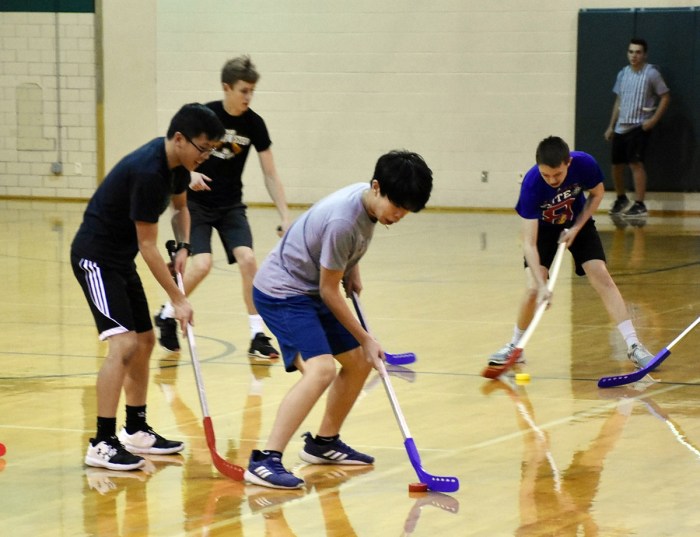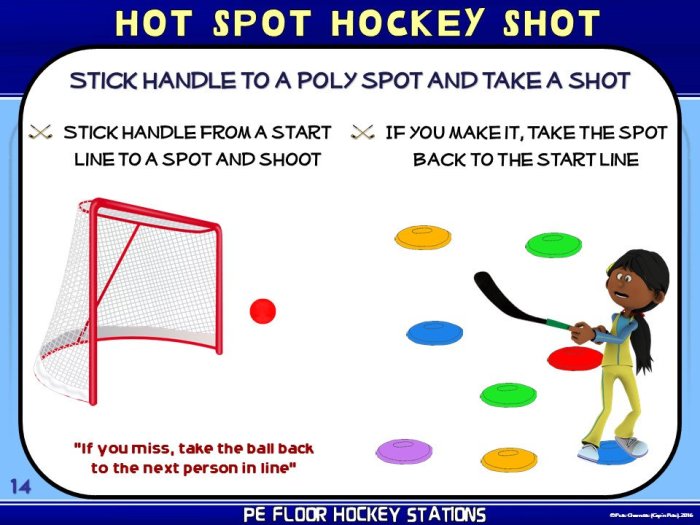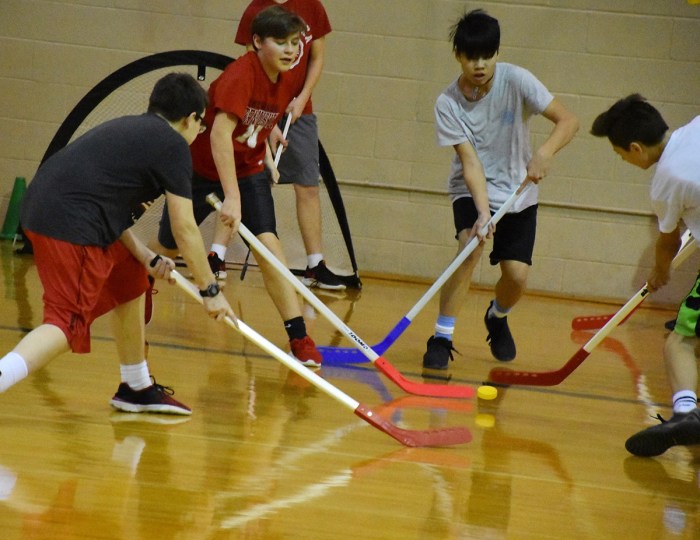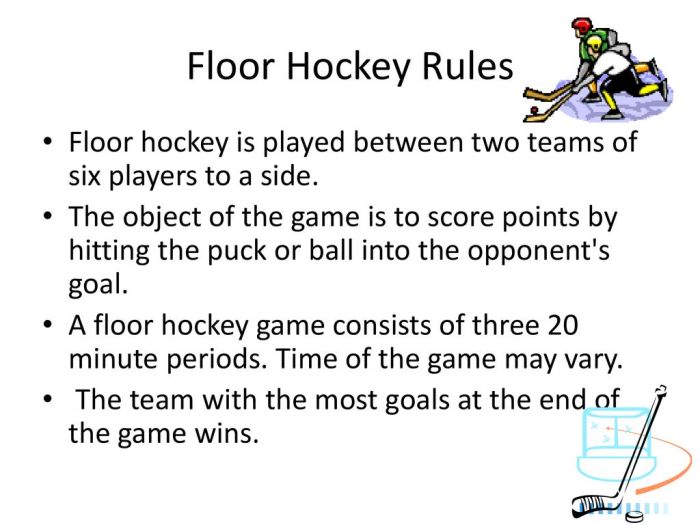Floor hockey rules for PE lay the foundation for an exciting game, providing clear guidelines for gameplay, equipment, fouls, and officiating. This comprehensive guide delves into the intricacies of floor hockey, ensuring a fair and enjoyable experience for all participants.
From the dimensions of the rink to the intricacies of penalty shots, this guide covers every aspect of the game, empowering players and educators alike to fully grasp the rules and regulations that govern this dynamic sport.
Basic Rules

Floor hockey, a dynamic indoor team sport, shares similarities with ice hockey, played on a flat surface with a ball and sticks.
The objective of floor hockey is to score goals by hitting a ball into the opponent’s net using a hockey stick. The team with the most goals at the end of the game wins.
A regulation floor hockey rink measures 200 feet (61 meters) long and 85 feet (26 meters) wide, with rounded corners.
Each team fields six players on the court at a time, including a goalkeeper.
Gameplay: Floor Hockey Rules For Pe

Floor hockey games typically last for 20-30 minutes, divided into two halves. The game starts with a face-off at the center of the court, and play continues until a goal is scored or the period ends. Goals are scored when the puck fully crosses the goal line and into the net.
Play is stopped when a goal is scored, when the puck goes out of bounds, or when a penalty is called.
Starting and Stopping Play
The game starts with a face-off at the center of the court. After a goal is scored, play is restarted with a face-off at the center of the court. When the puck goes out of bounds, play is restarted with a face-off at the nearest face-off spot.
When a penalty is called, play is stopped and the offending player is sent to the penalty box.
Scoring Goals
Goals are scored when the puck fully crosses the goal line and into the net. The puck must be shot or passed into the net, and it cannot be kicked or carried into the net. A goal is not scored if the puck is deflected into the net by a defending player or if the puck is knocked into the net by an attacking player’s stick.
Equipment

Floor hockey requires specific equipment to ensure safety and fair play.
Players need a hockey stick that is typically made of wood or composite materials. Sticks come in various lengths, and the length should be appropriate for the player’s height. The blade of the stick should be curved to allow for better control of the ball.
The curvature is regulated to prevent players from gaining an unfair advantage.
The floor hockey rules for pe are simple, yet effective. You’ll need to master the basics, like stick handling and passing, to be successful. Once you’ve got those down, you can start thinking about strategy and tactics. If you’re looking for some inspiration, check out the barber and ___ wife . It’s a great story about the importance of teamwork and communication.
And who knows, you might even learn a thing or two about floor hockey!
Protective Gear
Protective gear is crucial to minimize injuries during gameplay. Players must wear helmets with face masks, protective eyewear, shin guards, elbow pads, and gloves. Helmets are particularly important to prevent head injuries from collisions or falling objects. Protective eyewear shields players from stray balls or sticks.
Shin guards, elbow pads, and gloves offer protection from impact and abrasions.
Fouls and Penalties

Fouls occur when players break the rules of floor hockey. These can range from minor infractions to serious offenses. It’s important to be aware of the different types of fouls and their consequences to ensure fair play and safety.
Common Fouls
- Tripping: Using a stick or body to cause an opponent to fall.
- Hooking: Using the stick to catch or hook an opponent’s stick or body.
- Slashing: Striking an opponent with the stick.
- Cross-checking: Using the stick to check an opponent with both hands.
- Charging: Hitting an opponent with excessive force.
- Holding: Using the stick or body to prevent an opponent from moving.
- Interference: Obstructing an opponent’s path without the puck.
Consequences of Fouls
The consequences of fouls vary depending on the severity of the infraction. Minor fouls may result in a free hit or penalty shot, while serious fouls can lead to a suspension or disqualification.
Penalty Shot Procedure
A penalty shot is awarded when a player is fouled while on a breakaway and has a clear scoring chance. The player takes the shot from the penalty spot, located 12 feet from the goal, while the goalkeeper is in the net.
The penalty shot procedure is as follows:
- The player taking the shot must be designated by the referee.
- The player must place the puck on the penalty spot.
- The goalkeeper must remain in the goal crease until the puck is shot.
- The player has 10 seconds to shoot the puck.
- If the player scores, the goal counts.
- If the player misses the shot, the play continues.
Officiating

Ensuring fair play and adherence to rules is the responsibility of officials in floor hockey. Referees and linesmen work together to monitor the game and enforce penalties.
Roles and Responsibilities
- Refereesare responsible for starting and stopping play, awarding penalties, and enforcing the rules.
- Linesmenassist referees by monitoring offside violations, icing, and other infractions.
Signals, Floor hockey rules for pe
Officials use a series of signals to communicate during a game. These signals include:
- Face-off: Dropping the puck between two players to start play.
- Penalty: Indicating a player has committed an infraction.
- Goal: Signaling a goal has been scored.
Resolving Disputes and Enforcing Penalties
In case of disputes or disagreements, the referee’s decision is final. Referees may consult with linesmen or review video footage to make informed decisions.
Penalties are enforced by sending players to the penalty box for a specified period of time. Referees determine the severity of the infraction and assign the appropriate penalty.
User Queries
What is the objective of floor hockey?
The objective is to score more goals than the opposing team by hitting a ball into their net using a hockey stick.
How many players are allowed on the court for each team?
Typically, each team has six players on the court at a time.
What are the common fouls in floor hockey?
Common fouls include tripping, hooking, slashing, and cross-checking.
